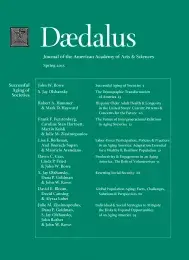Global Population Aging: Facts, Challenges, Solutions & Perspectives
The rapid aging of populations around the world presents an unprecedented set of challenges: shifting disease burden, increased expenditure on health and long-term care, labor-force shortages, dissaving, and potential problems with old-age income security. We view longer life spans, particularly longer healthy life spans, as an enormous gain for human welfare. The challenges come from the fact that our current institutional and social arrangements are unsuited for aging populations and shifting demographics; our proposed solution is therefore to change our institutions and social arrangements. The first section of this essay provides a statistical overview of global population aging and its contributing factors. The second section outlines some of the major challenges associated with widespread population aging. Finally, the third section of the essay describes various responses to these challenges, both current and prospective, facing individuals, businesses, institutions, and governments.
We are in the midst of an unprecedented transition in global demography. The world’s population is aging rapidly, and older adults compose a larger proportion of the world’s population than ever before–a share that will only increase over the next century. By 2050, the percentage of the United States’ population that is aged sixty years and older will grow from the current figure of about 20 percent to 27 percent. The global number of centenarians worldwide–those aged one hundred years and older–is expected to more than double by 2030, with projections of nearly 3.4 million by 2050.1 Three major factors are driving this transition: decreasing fertility, increasing longevity, and the aging of large population cohorts.
Falling fertility rates are the main determinant of population aging. Low fertility rates lead to smaller youth cohorts, which create an imbalance in the age structure: older age groups become larger than their younger counterparts. Thanks to accessible and effective birth control, increased child survival, and cultural changes, birth rates have dropped dramatically in the past century. In 1950, the global total fertility rate (TFR), or the average number of children per woman, was about 5; by 2010, that number had dropped by 50 percent. By 2050, the TFR will have dropped even further to about 2.25 children per woman. In many countries, fertility rates are now well below the long-term replacement rate of just over two children per woman.
Changes in fertility rate are accompanied by increased longevity, another driver of population aging. Averaging for sex and location, a child born in 1950 had a life expectancy of only forty-seven years, while an adult who had survived to the age of sixty could expect to live another fourteen years. In contrast, by 2010, life expectancy at birth had increased to seventy years, and continued life expectancy for those aged sixty increased to twenty years. In a number of populations, recent increases in longevity have been attributed to falling rates of tobacco consumption, as well as improvements in medical technologies.2 By 2050, life expectancy at birth is expected to have risen to nearly seventy-seven years, while life expectancy at age sixty will increase to twenty-two-and-a-half years.
Meanwhile, large population cohorts, such as the United States’ postwar baby boom generation, are moving through middle age and older adulthood. This movement can be seen in Figure 1, which depicts the population of more-developed countries (MDCs) broken down by sex and age group. Males are on the left side of the pyramid and females are on the right. The shifting shape of the population pyramid between the years 2010 and 2050 illustrates the baby boom cohort’s movement from middle into older ages.
These global phenomena–decreasing fertility, increasing longevity, and the aging of large birth cohorts–combine to drive up the percentage of older adults as a share of the global population. In 1950, only 8 percent of the world’s population was sixty years or older; this number increased to 11 percent by 2010. Over the next several decades, this proportion is expected to rise dramatically, reaching a projected 21.2 percent by 2050. The change is even more dramatic for the share of the world’s population aged eighty years or older. This proportion climbed from just 0.6 percent in 1950 to 1.6 percent in 2010, and is projected to make up 4.1 percent of the global population by 2050.
While the population of virtually every country is aging rapidly, there remains considerable variation at both regional and country levels, with strong correlations to differing income levels. MDCs trend toward low fertility and high longevity, and less-developed countries (LDCs) trend toward the opposite. At the low end of the fertility range are the MDCs found in Eu - rope and East Asia, with Bosnia, Herzegovina, and Singapore tied for the lowest TFR of 1.28 children per woman. Meanwhile, Sub-Saharan Africa has a regional TFR of just over 5, while also hosting the highest country-level fertility rates: Somalia (6.61), Mali (6.86), and Niger (7.58). As for longevity, Japan is in the lead with a current life expectancy at birth of eighty-three-and-a-half years, in stark contrast to Sierra Leone, where life expectancy at birth is slightly over forty-five years.
Tables 1 and 2 depict the percent of the elderly population in the world’s most and least population-aged countries, now (2010) and projected in the future (2050). The 2050 figures are based on a medium fertility projection, which assumes that fertility in all major areas will stabilize at replacement level (at slightly over two children per woman). This comparison reveals stark differences in age profiles between countries. For example, currently 23 percent of Germany’s population is aged sixty-five years and older, while the corresponding figure for Qatar (with its large expatriate worker population) is only 1 percent. These rankings are projected to shift considerably in the next half century, with only Japan holding over in the top five most population-aged nations. . . .
Access the full volume here.
